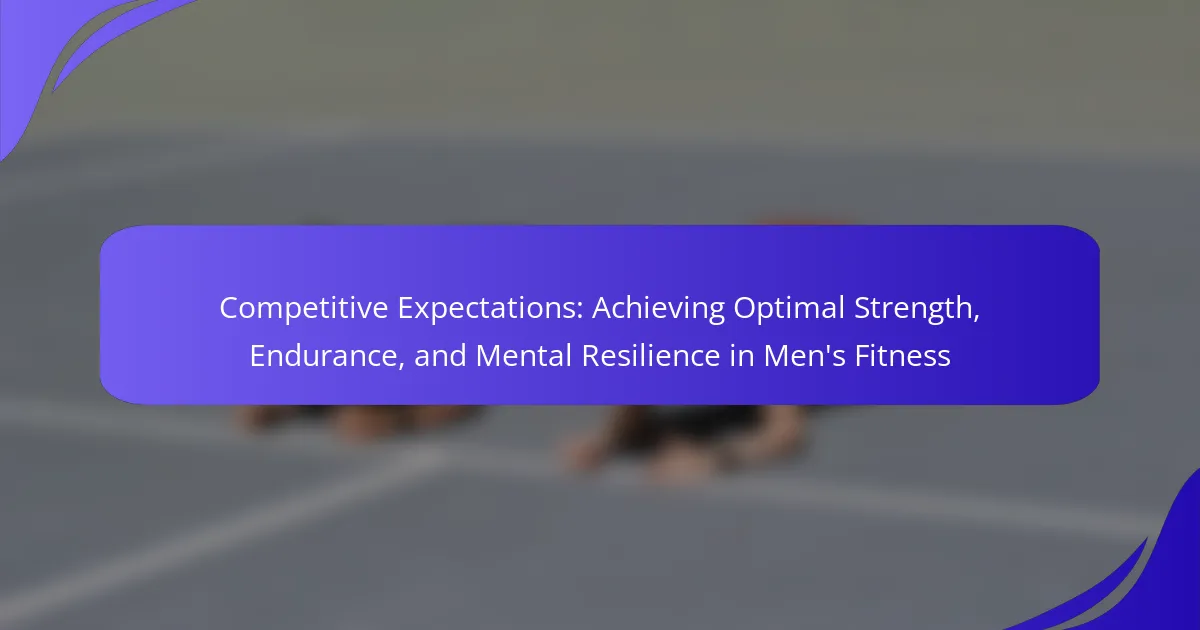Achieving optimal strength, endurance, and mental resilience is crucial for men in fitness. This article explores effective physical training methods, essential nutritional strategies, and mental resilience techniques. It addresses common challenges like unrealistic expectations and offers tailored approaches to enhance performance. By focusing on individualized plans and recovery optimization, men can reach their fitness goals more effectively.

What are the key components of optimal strength in men’s fitness?
Achieving optimal strength in men’s fitness involves three key components: physical training, nutrition, and mental resilience. Physical training focuses on resistance exercises, progressive overload, and varied routines to enhance muscle strength. Nutrition emphasizes protein intake, balanced macronutrients, and hydration to support recovery and growth. Mental resilience includes goal-setting, stress management, and motivation techniques to maintain consistency and performance.
How does muscle hypertrophy contribute to strength gains?
Muscle hypertrophy significantly enhances strength gains by increasing muscle cross-sectional area. This expansion allows for greater force production during resistance training. Additionally, hypertrophy improves neuromuscular efficiency, enabling better activation of muscle fibres. As a result, athletes can lift heavier weights and perform more repetitions, directly contributing to overall strength development.
What role does nutrition play in building strength?
Nutrition is crucial for building strength, providing essential nutrients that support muscle growth and recovery. A balanced diet rich in protein, carbohydrates, and healthy fats fuels workouts and enhances performance. For example, protein intake directly influences muscle protein synthesis, while carbohydrates replenish glycogen stores. Additionally, micronutrients like vitamins and minerals play a vital role in metabolic processes and overall health. Optimal nutrition not only improves physical strength but also contributes to mental resilience, enabling athletes to push through challenges.
Which training methods are most effective for increasing strength?
The most effective training methods for increasing strength include resistance training, high-intensity interval training (HIIT), and progressive overload. Resistance training focuses on lifting weights to stimulate muscle growth. HIIT combines short bursts of intense exercise with rest, enhancing strength and endurance. Progressive overload gradually increases the weight or resistance, ensuring continuous muscle adaptation.
What are the benefits of progressive overload?
Progressive overload enhances strength, endurance, and mental resilience in men’s fitness. It leads to continuous improvement by gradually increasing the demands on the body. This approach results in better muscle adaptation, increased endurance capacity, and improved psychological toughness. Regularly challenging oneself fosters a growth mindset, essential for long-term success in fitness.
How can compound exercises enhance strength?
Compound exercises enhance strength by engaging multiple muscle groups simultaneously, leading to greater overall muscle activation. This results in improved functional strength and efficiency during physical activities. Additionally, they promote hormonal responses that contribute to muscle growth and endurance. For example, squats and deadlifts not only build leg strength but also engage the core and back, fostering a balanced physique. As a result, incorporating compound exercises into training regimens can significantly elevate competitive performance in men’s fitness.

What strategies enhance endurance for competitive performance?
To enhance endurance for competitive performance, focus on structured training, nutrition, and mental strategies. Implement interval training to boost aerobic capacity and strength training to improve overall power. Prioritise a balanced diet rich in carbohydrates, proteins, and healthy fats to fuel workouts and recovery. Incorporate mental resilience techniques, such as visualization and mindfulness, to maintain focus during competition. Regularly assess progress and adjust strategies to optimize performance.
How does cardiovascular fitness affect overall endurance?
Cardiovascular fitness significantly enhances overall endurance by improving oxygen delivery and utilization in muscles. This leads to increased stamina during physical activities. Enhanced heart efficiency, lower resting heart rate, and improved blood circulation are key benefits of cardiovascular fitness. As a result, individuals can sustain prolonged exercise, which is crucial for achieving optimal strength and mental resilience in competitive fitness.
What types of endurance training are most beneficial?
Endurance training types like long-distance running, cycling, and swimming are most beneficial for building stamina. These activities enhance cardiovascular health, improve muscular endurance, and boost mental resilience. Incorporating interval training can also provide unique benefits by increasing anaerobic capacity and overall performance. Additionally, cross-training with strength workouts can prevent injuries while optimizing endurance gains.
How do interval training and steady-state cardio compare?
Interval training provides higher intensity and faster results in strength and endurance compared to steady-state cardio. Interval training improves aerobic and anaerobic capacity, while steady-state cardio offers sustained fat burning. Interval training typically lasts 20 to 30 minutes, whereas steady-state sessions can extend to 60 minutes or more. Both methods enhance mental resilience, but interval training may lead to greater psychological benefits due to its challenging nature.
What is the importance of recovery in endurance training?
Recovery is crucial in endurance training as it enhances performance, reduces injury risk, and promotes mental resilience. Adequate recovery allows muscles to repair and adapt, leading to improved strength and endurance over time. Studies show that incorporating active recovery can increase overall training efficacy by up to 20%. Prioritising recovery strategies, such as sleep, nutrition, and hydration, supports sustained competitive performance in men’s fitness.

What mental resilience techniques are effective for athletes?
Mental resilience techniques effective for athletes include visualization, mindfulness, and positive self-talk. These strategies enhance focus, reduce anxiety, and improve performance under pressure. Visualization allows athletes to mentally rehearse successful outcomes, while mindfulness helps maintain present-moment awareness. Positive self-talk fosters confidence and motivation, crucial for overcoming challenges in competitive environments.
How does mindfulness impact performance under pressure?
Mindfulness enhances performance under pressure by improving focus, reducing anxiety, and fostering mental resilience. Practicing mindfulness techniques can lead to better decision-making and increased strength and endurance in competitive fitness. Studies indicate that athletes who engage in mindfulness report lower stress levels and improved emotional regulation, which directly correlates with enhanced performance metrics. By incorporating mindfulness into training regimens, individuals can achieve optimal mental states that support their physical capabilities.
What cognitive strategies can improve mental toughness?
Cognitive strategies to improve mental toughness include visualization, positive self-talk, and goal setting. Visualization helps athletes mentally rehearse performance, enhancing focus and confidence. Positive self-talk fosters resilience by countering negative thoughts. Goal setting provides clear targets, promoting motivation and persistence. These strategies contribute to achieving optimal strength, endurance, and mental resilience in men’s fitness.
How can visualization techniques enhance competitive outcomes?
Visualization techniques significantly enhance competitive outcomes by improving focus, motivation, and performance. They help athletes mentally rehearse their actions, leading to increased confidence and reduced anxiety. Research shows that mental imagery can enhance strength and endurance by promoting neural pathways associated with physical performance. Athletes who regularly use visualization report better mental resilience, which is crucial in high-pressure situations. This technique serves as a unique attribute that distinguishes successful competitors in men’s fitness.
What role does goal-setting play in building resilience?
Goal-setting is crucial for building resilience as it provides direction and motivation. By establishing clear, achievable objectives, individuals enhance their mental fortitude, enabling them to navigate challenges. Research indicates that setting specific goals increases persistence and focus, which are essential for overcoming obstacles in fitness journeys. This structured approach fosters a sense of accomplishment, reinforcing confidence and determination. Ultimately, effective goal-setting cultivates a resilient mindset, vital for achieving optimal strength and endurance in men’s fitness.

What are the common challenges faced by men in achieving these goals?
Men face several challenges in achieving optimal strength, endurance, and mental resilience in fitness. Common obstacles include unrealistic competitive expectations, which can lead to burnout and injury. Many men struggle with balancing fitness goals and daily responsibilities, causing inconsistency in training. Additionally, mental barriers, such as self-doubt and anxiety, hinder performance. Nutritional knowledge gaps can also impact progress, as proper diet is crucial for achieving fitness objectives. Lastly, lack of access to resources or supportive communities can further impede success.
How can time management be optimized for fitness training?
To optimize time management for fitness training, prioritise structured planning and flexibility. Establish a consistent schedule that includes strength, endurance, and mental resilience workouts. Utilize tools like fitness apps for tracking progress and adjusting routines based on performance metrics. Incorporate short, high-intensity sessions to maximize results in limited time. Balance training with recovery to prevent burnout and enhance overall performance.
What psychological barriers hinder progress in strength and endurance?
Psychological barriers such as fear of failure, self-doubt, and perfectionism hinder progress in strength and endurance. These barriers can lead to decreased motivation and performance anxiety. Fear of failure often prevents individuals from pushing their limits, while self-doubt undermines confidence in abilities. Perfectionism creates unrealistic expectations, leading to frustration and burnout. Addressing these psychological factors is crucial for enhancing mental resilience and achieving optimal fitness outcomes.

What unique attributes can set competitive athletes apart?
Unique attributes that set competitive athletes apart include exceptional mental resilience, advanced recovery strategies, and tailored nutrition plans. Mental resilience allows athletes to maintain focus under pressure, enhancing performance. Advanced recovery strategies, such as cryotherapy and active recovery, optimize physical readiness. Tailored nutrition plans ensure athletes meet specific energy and nutrient needs, supporting peak performance. These attributes collectively contribute to a competitive edge in men’s fitness.
How does genetic predisposition influence strength and endurance?
Genetic predisposition significantly influences both strength and endurance in fitness. Genetic factors determine muscle fibre composition, influencing how individuals respond to training. For example, those with a higher proportion of fast-twitch fibres may excel in strength, while those with more slow-twitch fibres may have better endurance. Additionally, genetic variations affect recovery rates and overall performance, impacting competitive expectations in men’s fitness. Understanding these genetic influences can help tailor training programs for optimal results.
What innovative training technologies are available for men’s fitness?
Innovative training technologies for men’s fitness include wearable devices, virtual training platforms, and AI-driven fitness apps. These tools enhance strength, endurance, and mental resilience. Wearable devices track performance metrics, providing real-time feedback. Virtual training platforms offer personalized coaching experiences, fostering motivation and accountability. AI-driven apps analyze user data to customize workout plans, optimizing results and engagement. These technologies collectively support competitive expectations in men’s fitness.

What rare attributes should be considered for peak performance?
To achieve peak performance in men’s fitness, consider rare attributes such as individualized training plans, recovery optimization techniques, and mental conditioning strategies. These factors can significantly enhance strength, endurance, and mental resilience. Individualized training plans cater to unique body types and fitness levels, ensuring optimal progress. Recovery optimization techniques, like active recovery and sleep quality enhancement, promote muscle repair and overall performance. Mental conditioning strategies, including visualization and mindfulness, foster resilience under competitive pressure.
How can hormonal balance affect fitness outcomes?
Hormonal balance significantly influences fitness outcomes by optimizing strength, endurance, and mental resilience. Hormones like testosterone and cortisol directly impact muscle growth, recovery, and energy levels. For example, balanced testosterone levels enhance muscle protein synthesis, while excessive cortisol can hinder recovery and increase fatigue. Maintaining hormonal equilibrium fosters better performance in competitive fitness, promoting overall well-being and resilience.
What are the implications of age on strength and endurance?
Age significantly impacts strength and endurance, with declines typically observed as individuals grow older. Muscle mass generally decreases by approximately 3-8% per decade after age 30, affecting strength. Endurance also diminishes, often linked to cardiovascular efficiency and recovery time. Regular training can mitigate these effects, enhancing both attributes regardless of age. Research indicates that older adults can still achieve substantial strength gains through resistance training, emphasizing the importance of tailored fitness programs.

What best practices can help men optimise their fitness journey?
To optimize their fitness journey, men should focus on setting realistic goals, maintaining consistency, and integrating strength training with cardiovascular exercises. Prioritise nutrition by consuming a balanced diet rich in protein, healthy fats, and carbohydrates to fuel workouts. Mental resilience can be enhanced through mindfulness practices and goal visualization. Tracking progress regularly helps in adjusting strategies and staying motivated.
What are the most effective recovery strategies after intense training?
Effective recovery strategies after intense training include proper hydration, nutrition, adequate sleep, and active recovery techniques. Hydration replenishes lost fluids, while nutrition provides essential nutrients for muscle repair. Aim for 7-9 hours of quality sleep to enhance recovery and mental resilience. Active recovery, such as light exercise or stretching, promotes blood flow and reduces soreness. Incorporating these strategies optimizes strength and endurance, crucial for competitive fitness.
How can men avoid common mistakes in their fitness regimens?
To avoid common mistakes in fitness regimens, men should focus on realistic goals and consistency. Setting achievable milestones fosters motivation and prevents burnout. Emphasizing strength, endurance, and mental resilience is crucial. For example, incorporating progressive overload enhances strength while varied training improves endurance. Additionally, prioritising recovery supports long-term performance. Understanding these elements helps men optimize their fitness journey.
What expert insights can guide men in achieving their fitness goals?
To achieve fitness goals, men should focus on setting realistic expectations, incorporating strength training, enhancing endurance, and developing mental resilience. These elements are crucial for overall performance and well-being.
Strength training improves muscle mass, which boosts metabolism and enhances physical capabilities. Endurance activities, such as running or cycling, increase cardiovascular health and stamina. Mental resilience is vital for overcoming challenges and maintaining motivation.
Incorporating a structured routine that balances these aspects can lead to optimal results. For example, combining weightlifting with high-intensity interval training can maximize strength and endurance simultaneously.
Tracking progress through measurable goals, such as lifting heavier weights or running longer distances, fosters accountability and encourages continuous improvement.



